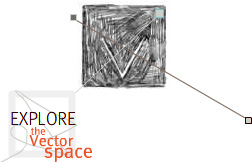Mobile Figures
Design by Erik Loyer
Editor's Introduction
If 'mobility' seems very much a buzz word of the new millennium, packaged and sold to us via an ever-increasing array of sleek and shiny devices, 'Mobile Figures' insists we think the term historically and culturally by routing us back to an earlier place and time. The piece explores a series of contradictory figurations of the Irish during the period of the Famine in order to understand the work such representations perform for capital, for empire, and for the Irish themselves. As such, "Mobile Figures" sheds light on our contemporary moment of globalization, as the 19th-century movements of the Irish provide one trajectory through which we might historicize and analyze the accelerated processes of diaspora and displacement that so characterize late capitalism.
In an early design meeting for the project, David Lloyd expressed the hope that the piece might produce in the reader a feeling akin to dropping into a bog, a sense of displacement and radical reorganization. As such, he was interested in mining the affective registers of argument set free from the strict linearity of the traditional essay, opening up the possibility for contingency, juxtaposition, accident, and meandering as modes of scholarly engagement. Through a process of iterative collaboration, Creative Director Erik Loyer and Lloyd have succeeded in modeling a more rhizomatic form of scholarship that simultaneously sustains linear argument and pushes hard against it. In deploying this 'both/and' logic, the piece points to new modes of historiographic inquiry by forging points of intersection between oft-distinct modes of thought, linking up political economy, visual culture, literary theory, and an investigation of subaltern agency. It creates a space for those associative lines of thought that regularly get pruned away as we force our ideas into the confines of linear print. Through the Vectors collaboration process, it also became clear that Lloyd was unearthing fresh dimensions to his argument, allowing a new 'form' to reshape what he could do and say with 'content' he knew quite well.
Such a multi-layered structure is exquisitely appropriate to the subject matter at hand, for one of the lessons of the piece is to remind us that the Irish were at once reified in their figuration by the British and always also outstripping that very fixity, enabling and escaping the logics and rationalizations of capital at one and the same time. In their mobility and their stasis, the Irish limn both the dream of perfect abstract labor and the impossibility of that dream's full realization.



